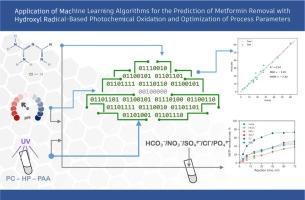Application of machine learning algorithms for the prediction of metformin removal with hydroxyl radical-based photochemical oxidation and optimization of process parameters
IF 12.2
1区 环境科学与生态学
Q1 ENGINEERING, ENVIRONMENTAL
引用次数: 0
Abstract
This study investigated the effectiveness of hydroxyl radical-based photochemical oxidation processes on metformin (METF) removal, and the experimental data were modeled by machine learning (ML) algorithms. Hydrogen peroxide (HP), sodium percarbonate (PC), and peracetic acid (PAA) were used as hydroxyl radicals sources. Modeling was conducted using ML algorithms with the integration of additional experiments. Under optimum conditions (UV/PC: pH 5, PC 6 mM, UV/HP: pH 3, HP 6 mM, UV/PAA: pH 9, PAA 6 mM), the METF removal efficiency was 74.1 %, 40.7 %, and 47.9 % with UV/PC, UV/HP, and UV/PAA, respectively. The scavenging experiments revealed that hydroxyl and singlet oxygen radicals were dominant in UV/PC and hydroxyl radicals were predominant in UV/HP and UV/PAA. Nitrate negatively affected UV/HP, UV/PC, and UV/PAA, whereas chlorine had a positive impact. The EE/O were 0.682, 1.75, and 1.41 kWh/L for UV/PC, UV/HP, and UV/PAA, respectively. The experimental results were successfully modeled by ML models with high R2 values and low MAE and RMSE values. XGBoost models effectively represent data with generalization by avoiding overfitting. Using ML algorithms to model hydroxyl radical-based photochemical oxidation processes is considered an effective and practical method for future research.

本研究探讨了基于羟基自由基的光化学氧化过程对二甲双胍(METF)的去除效果,并利用机器学习(ML)算法对实验数据进行了建模。过氧化氢(HP)、过碳酸钠(PC)和过乙酸(PAA)被用作羟基自由基源。使用 ML 算法并结合其他实验进行建模。在最佳条件下(UV/PC:pH 5,PC 6 mM;UV/HP:pH 3,HP 6 mM;UV/PAA:pH 9,PAA 6 mM),UV/PC、UV/HP 和 UV/PAA 对 METF 的去除率分别为 74.1%、40.7% 和 47.9%。清除实验表明,UV/PC 以羟自由基和单线态氧自由基为主,UV/HP 和 UV/PAA 以羟自由基为主。硝酸盐对 UV/HP、UV/PC 和 UV/PAA 有负面影响,而氯则有正面影响。UV/PC、UV/HP 和 UV/PAA 的 EE/O 分别为 0.682、1.75 和 1.41 kWh/L。ML 模型成功地对实验结果进行了建模,具有较高的 R2 值和较低的 MAE 和 RMSE 值。XGBoost 模型通过避免过度拟合,有效地表示了数据的概括性。使用 ML 算法对基于羟基自由基的光化学氧化过程进行建模被认为是未来研究中一种有效而实用的方法。
本文章由计算机程序翻译,如有差异,请以英文原文为准。
求助全文
约1分钟内获得全文
求助全文
来源期刊

Journal of Hazardous Materials
工程技术-工程:环境
CiteScore
25.40
自引率
5.90%
发文量
3059
审稿时长
58 days
期刊介绍:
The Journal of Hazardous Materials serves as a global platform for promoting cutting-edge research in the field of Environmental Science and Engineering. Our publication features a wide range of articles, including full-length research papers, review articles, and perspectives, with the aim of enhancing our understanding of the dangers and risks associated with various materials concerning public health and the environment. It is important to note that the term "environmental contaminants" refers specifically to substances that pose hazardous effects through contamination, while excluding those that do not have such impacts on the environment or human health. Moreover, we emphasize the distinction between wastes and hazardous materials in order to provide further clarity on the scope of the journal. We have a keen interest in exploring specific compounds and microbial agents that have adverse effects on the environment.
 求助内容:
求助内容: 应助结果提醒方式:
应助结果提醒方式:


